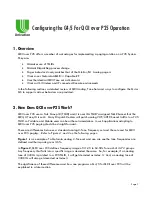
Page 1
Configuring the G4/5 For QCII over P25 Operation
1.
Overview
QCII over P25 offers a number of advantages for implementing a paging solution on a P25 System.
They are:
•
Minimizes use of TGIDs
•
Minimal Dispatching process change
•
Pager behavior closely matches that of the Minitor/G1 Analog pagers
•
Works over Motorola ABME++ Capable RF
•
Uses the identical QCII Tone set as Motorola
•
Works with Wireless and IP connected Console environments
In the following sections a detailed review of QCII coding, Tone Sets and ways to configure the G4 or
G5 to support various behaviors are provided.
2.
How Does QCII over P25 Work?
QCII over P25 uses a Talk Group ID (TGID) and it is over this TGI
D’s assigned Talk Channel that the
QCII, 2-Tone, ID is sent. Many Dispatch Centers will patch analog VHF/UHF Channel traffic to a P25
TGID so Portable and Mobile users can hear these transmissions. In such applications adopting to
QCII over P25 paging should be straightforward.
There are differences between a standard analog 2-Tone frequency set and the set used for QCII
over P25 paging.
Refer to Figures 1 and 2 on the following pages.
Figure 1
is an example of a Motorola analog 2-Tone set and one can see the tone frequencies are
defined and their spacing runs 3-6%.
In
Figure 2
, QCII over P25 defines frequency range of 31.25 to 62.5Hz for each of its 72 groups.
Any frequency that falls into a specific range is decoded the same. So, for example, if an analog
tone of 349Hz is patched to a P25 TGID, it will get decoded as Index 3. And, an analog tone of
330.5Hz will also get decoded as Index 3.
The significance of these differences and how one programs a G4/5 for QCII over P25 will be
explained in a later section.
Содержание G4
Страница 2: ...Page 2 Figure 1...
Страница 3: ...Page 3 Figure 2...
Страница 7: ...Page 7 Figure 7 Figure 8...
Страница 12: ...Page 12 Figure 1A Figure 2A...
Страница 13: ...Page 13 Figure 3A Figure 4A...
















